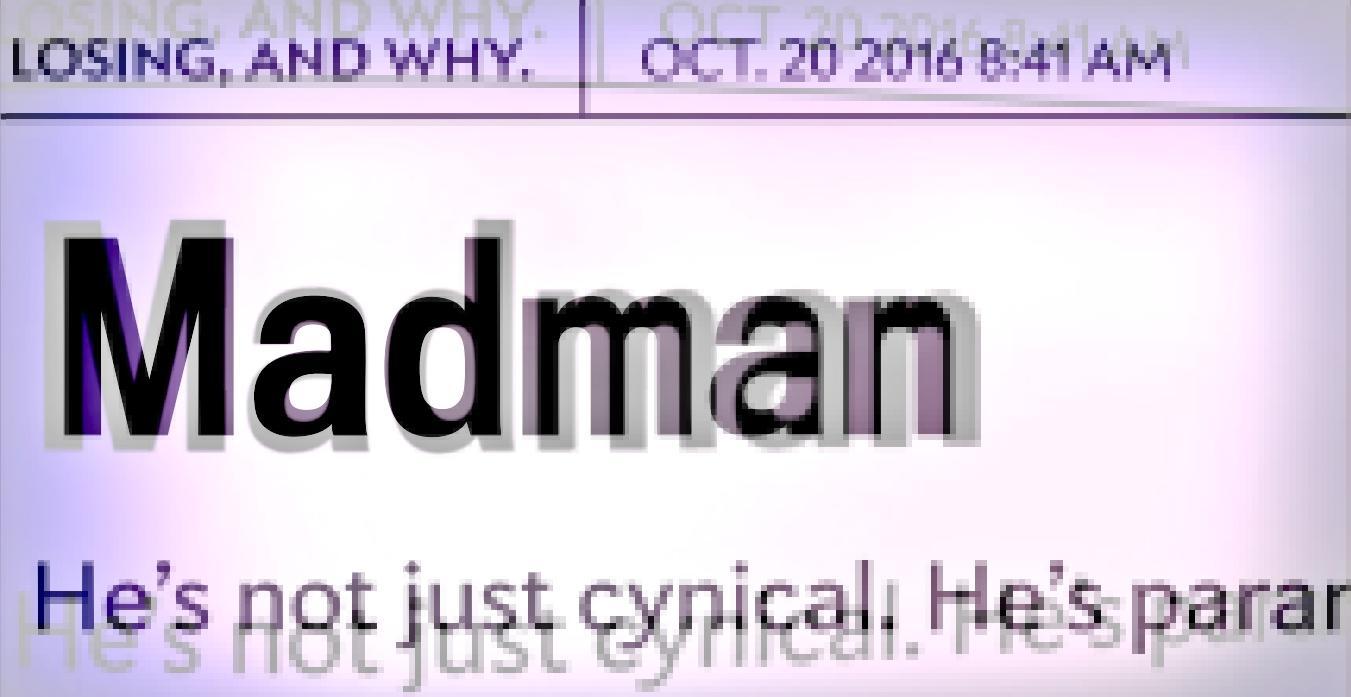
This is not about Donald Trump. It’s about the language we use talking about mental illness.
It’s been a long, ugly march out of the “madhouses” of American history. But for those millions who suffer from conditions like depression, obsession-compulsive disorder, or ADHD, the playground taunting, the workplace sneers, and often critical comments from their peers are not so far distant. They’re still an everyday thing.
But while housing discrimination, employment, criminalization, and bullying are still with us, the language we use about mental illness has thankfully shifted. This is important, because it is language that frames reality and leads to long-term change.
Those deemed out of place or “weird” aren’t met so much with the dreaded sign, fingers twirling around ears, followed by a dangerous point their way. We hear less and less about kids and adults being “maniacs,” and “crazies,” and “nutzos.” Progress is being made.
Then along came Trump.
The man’s self-absorption. His anti-immigrant rhetoric. The base attitudes and behaviors toward women. With this daily parade of offensiveness lain out before us, many, overcoming their initial revulsion, began to ask each other quietly: “Is something wrong with him?” ‘Wrong’ being one of those code words, you know.
Journalists followed up. Was there a story in the man’s mental health history? Did it disqualify him for that high office?
The resulting coverage hasn’t been perfect, but it has, on the whole, tended toward reasonableness. That is, the illness—most seem to prefer the idea of Trump as a walking case of narcissistic personality disorder—has been addressed separately from the man. That is, Trump is not his illness, the illness is not him.
This doesn’t make him any easier to like as a person, but it is a prerequisite when discussing mental health.
However, rushing to launch an attention-grabbing headline above the heads of those hundreds of writers now lapping the perspiration up off the debate-room floor, William Saletan at Slate pushed out this doozy:
The piece obviously went through a few rounds of quick edits judging from the url promising a discussion of “american fascism” that isn’t ultimately provided (donald_trump_and_the_paranoid_style_in_american_fascism.html).
Now “madman” is certainly still fair vernacular. It makes perfect sense when talking about a genocidal warlord. Or a power-mad politician with his finger on the button. The best I’m prepared to offer Trump here is a rank of “aspiring” madman.
Others are more liberal in their usage. The New York Post allows room for meat-cleavering geriatrical attacks. Nice new company, Slate.)


Calling Trump a “madman” really isn’t the issue. The issue is calling him a “madman” in the context of mental health. Because, to be sure, we use the word to describe people acting erratically, wildly, which Trump certainly does. We use it, admiringly even, to describe people who take awesome risks, oftentimes in a sports context. Cliff diving, for instance.
In less flattering usage, “madman” has been that linkage fusing mental illness in the public mind with violent criminal behavior.
There’s a reason the term is on the way out when it comes to mental illness. That’s because after decades of advocating for their rights, those who live alongside mental illness, whether their own or that of a loved one, have refused to accept such derogatory labels.
“Cuckoo” is on the ropes, thanks to a more sensitized public (and the decline of heritage clockmaking). Even “nuts” seems to be slipping.
Yet as someone proudly non-conforming to the “neurotypical” template (#madpride, y’all), I can attest that this struggle for understanding is very much ongoing.
If you need evidence of that, just consider the state of mental health care in America—that in spite of the fact that an estimated one in four people suffer from clinical depression. [I’ve written about this in depth in my book, “After Depression.”]
This is why this sort of reporting must be resisted, regardless of our level of disgust with the candidate.
What Saletan has done here is not just re-insert talk of “madmen” into discussion of mental illness, he has collapsed the bar when it comes to considering who qualifies for this most nefarious label.
To read the article, we move quickly from the “madman” in the headline to the first-sentence assessment that Trump is “mentally ill.” And what particular manifestation of mental illness is it that qualifies him for the most abusive rank of “madman”? Donald Trump is “paranoid.”
Donald Trump is mentally ill. After 16 months of campaigning and three general election debates, this has become all too clear. Trump sees himself as the victim of a web of conspiracies encompassing House Speaker Paul Ryan, the FBI, the CIA, and the Iraqi military. He sees events in his life—women who claim to have met him, violence by supporters at his rallies—as tentacles of these plots. He refuses to accept the outcome of the election, and he demands that his opponent be jailed, not because Trump is cynical but because he is paranoid.
Cue the timelapse wilting flowers.
If you missed it on the first run, here’s the algebra on that:
Paranoid > Mentally Ill > Madman.
I immediately tweeted Saletan.
@Saletan To use "mentally ill" and "madman" synonymously is to pour kerosene on the #stigma of #mentalillness. Re: https://t.co/byLWIqwGR5
— Gregory Harman (@gharman) October 20, 2016
But as I began to line up follow-up tweets, I realized there was no way to express my disappointment in a couple one-liners.
I wanted to tell him that there is actually a way to talk about Donald Trump and mental illness that doesn’t shame the mentally ill.
I wanted to suggest that he explore the armchair Trump/narcissist breakdown at Psychology Today.
Surely he remembers the sprawling and captivating feature that ran in the Atlantic this summer.
The thing is, when Saletan puts on his psychiatrist hat to diagnose Donald Trump’s “paranoia” as a “mental illness” that qualifies the man as a certified “madman,”he is causing real damage for people who struggle under the many labels I’ve listed in this post.
By his metric, Saletan is essentially calling the millions of Americans who suffer from clinical paranoia and panic disorder and schizophrenia and bipolar disorder “maniacs.”
He is reviving the worst terminology we have in the mental health lexicon to describe someone who, by Saletan’s own suggestion, is merely paranoid. Granted paranoia matched with power is a bad mix, but that’s its own conversation. It can be had productively outside of any forced mental-health assessments.
The “cuckoo clock” is chiming again. And not in a good way.









